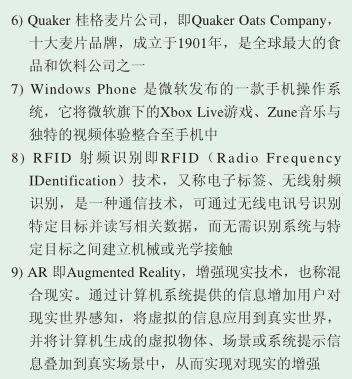人人都爱二维码
2013-04-08
Forget the bad press, the QR code seems like such a clever idea: Like a smarter barcode for the 21st century, it hooks up through your smartphone or computers camera to some code that reads it, and translates its spotty pattern into a URL, or a phone number, or a passage of text, or a digital business card—all instantaneously. Theyve been used all over the globe for ages, but the tech is having a moment in the U.S.
Check out 2)Victorias Secrets new“Sexier Than Skin” ad campaign—I bet it already grabbed your eye. Its new, undeniably clever, certain to tempt many a viewer into trying QR codes in a way that perhaps no other ad ever has, and its so “3)meta” (with the tech itself acting as part of the visual joke) its hard to imagine the ad campaign working any other way. By holding a smartphone up to the ad, snapping the QR code and waiting to see what happens, the interested “viewer” is automagically taken to a URL for an image that fills in the gap, not with saucy pink 4)pixels but with saucy underwear.
撇开负面新闻来看,二维码看起来像是一个极为聪明的想法:就如为21世纪而生的更加智能的条码,它能够通过智能手机或电脑的摄像头来与那些能够被识别的代码相连,然后再将这些星星点点的图案翻译成一条链接地址,或者一个电话号码,或者一段文字,又或是一张数码名片——全都在瞬间完成。二维码在全球范围内已被应用多年了,但这项技术如今在美国才算达到了其极盛时刻。
查看一下“维多利亚的秘密”那名为“比肌肤更性感”的新广告——我猜你必会一下子被它吸引住。这广告确实又新鲜又聪明,采用了一种其它广告从未试过的方式,肯定能吸引许多看客去尝试二维码。而且它极具诠释性(采用的这项技术本身已使之成为视觉幽默中的一部分),因此很难想象这个广告以任何其它的方式能达到这样的效果。通过拿着智能手机对着广告,快速拍下二维码,接着就是等着看有什么事情发生,感兴趣的“看客”会自动奇幻地被带到一个链接地址去,然后看到一幅刚好填满空缺的图片,上面不是情色的粉色马赛克,而是俏丽的内衣。
Then check out the odd news from a recent survey by Vizibility Inc. of legal professionals in the U.S. in July and August. Among the various results: 85% of legal marketers surveyed were aware of QR code technology; 35% already use them; and a further 45% plan on using them in the next 12 months. That means 80% of legal professionals could be using QR codes inside a year. In the data-rich world of lawyers in the U.S., the codes are useful for marketing (so a simple advert can link to rich biographical data and contact info) and also enable a simple paper business card to link to a website, or transmit useful contact details directly to a prospective clients cell phone.
A firm called Pet Check is taking dog walking into the 21st century, with clients able to track their 5)poochs progress around the walking route online, via GPS. QR code tags are a crucial part of the model, enabling hassled walkers to quickly “check in” a dog and check them out again at the end of the walk. The firm just launched in California, and has plans to go nationwide.
In the fashion world, iconic American fashion brand Polo Ralph Lauren was a superearly adopter of QR codes for use with mobile shopping and marketing.
再来看看由Vizibility公司于七月和八月对美国法律专业人士近期做的一份调查,其中反映出的情况值得关注。在各种不同的结果中显示:受访的法律营销人员中,有85%都知道二维码技术;有35%的人已经在使用;另外有45%的人打算在未来的一年内使用。那也就是说在一年内可能将有80%的法律专业人士使用二维码。在美国律师们那信息丰富的世界里,代码对于营销来说非常有用,(如此简单的一个广告就能连接到大量的传记式资料和联系信息),还能使得一张简单的纸质名片连接到一个网站,或是把有用的联系方式直接传送到潜在客户的手机上。
一家叫做“宠物追踪”的公司把遛狗一事推进了21世纪,通过全球定位系统客户们可以在线跟踪他们的小狗在既定路线上的行动。而二维码标签则是这个系统中关键部分,能让充满困扰的遛狗者迅速地给狗进行“登记”,然后再在行程结束时给它退出系统。这家公司刚在加利福尼亚州开始这项业务,并打算向全国推广。
在时装界,美国服装大牌拉夫·劳伦则在手机购物和营销上一大早就采用了二维码。
6)Quaker, a food firm you may not necessarily think of as being hugely 21st century, has just launched a QR code-enabled promotional campaign to push sales of its Chewy Granola bars via a digital personal message from Nick Jonas. The clip is accessed by a QR code printed on the box, and the campaigns pinnacle is a personalized message to the buyers child for a birthday or good luck message in which Jonas uses the childs name.
Temple City Chamber of Commerce just installed its first QR signpost—the first of many planned—as a way of sharing information about the city, and navigating tourists and locals to relevant parts of the citys website. Microsoft is embracing the tech as a dynamic and superswift way to link game data from a console like the Xbox 360 to partner games on a 7)Windows Phone smartphone. And there are countless other companies of all sorts, right down to real estate agents in the U.K., inspired by rapid adoption by U.S. firms, thatre rushing to embrace the tech.
桂格,一家你未必觉得非常时髦的食品公司,刚刚启动了一场用二维码进行促销的活动,活动方式是通过(当红歌手)尼克·乔纳森发送的个人数字短信来推销它的可嚼格兰诺拉燕麦条。这段短片需要通过读取包装盒上的二维码来获得,而这项活动最吸引人之处则是消费者的孩子可以收到一条来自乔纳森的生日或好运祝福短信,短信中还个性化地用上孩子的名字。
天普市商会刚安装好它的第一个二维码路标——计划中还有很多个——以此作为一种分享城市信息的方式,还可以为游客和居民提供连接到城市相关网站的导航服务。微软公司很喜爱这项技术,视它为一种充满活力的超级快链接方式,通过它就能将游戏机Xbox 360等游戏机上的游戏数据连接到微软系统智能电话上的合作游戏上去。还有数不尽的其他各行各业的公司,甚至到英国的房地产代理,皆从美国的公司获得灵感并迅速应用上这项技术。
Theres one simple reason for this: The smartphone revolution. Were buying them by the billion, and pretty much every one comes with a camera thats good enough to quickly and easily snap a photo of a QR code and pass the data to a relevant app—instantly linking a real-world piece of data to a digital portal for enhanced content. Yes the technology is about to be replaced—with a bevy of alternatives, from 8)RFID-tagged stickers, posters, and products to real-world object recognition in augmented reality smartphone apps. But QR codes, now seemingly booming in the U.S., arent likely to be going anywhere soon.
Compared to some alternatives theyre supersimple to integrate into products (requiring merely a spatter or two of ink, and thus easily incorporated into typical printing runs) and cheap too. And as we highlighted previously, in comparison to 9)AR object recognition in which a real world object is unidentifiably “tagged” until it reveals itself in an app, QR codes are visible and self-advertising...consumers know what to do with em.
在这个现象背后有一个极为简单的理由:智能手机革命。人们购买智能手机的数量以十亿计,而且几乎每一部手机都带有足够快速并且能轻易拍下二维码的摄像头,并能把数据传送到相关的应用程序去——瞬间就将一张真实世界中的编码连接到一个充满增强内容的数字门户。没错,这项技术很快就会被取代——有很多替补者等着,从含射频识别标签的贴纸、海报及产品,到增强现实智能手机应用程序中的实物识别。然而二维码,如今似乎正在美国蓬勃发展,不太可能那么快就退出。
与一些替代品相比,二维码极容易与产品相结合(仅需要一两滴油墨,因此很容易与标准印刷品整合)而且也价格低廉。而且正如我们前面强调过的,在增强现实实物识别技术中,如果某件现实物品不能先在应用程序中被呈现出来则无法辨认,无法被加以“标签”,与此技术相比,二维码明显可见又能自我推广……消费者懂得如何使用。

